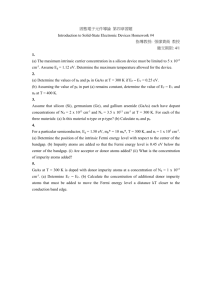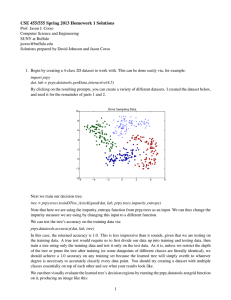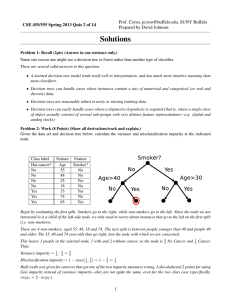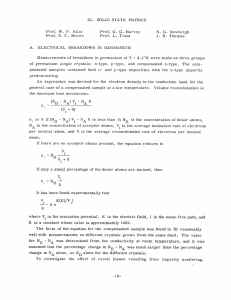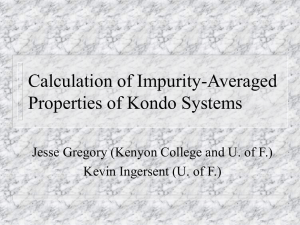RESEARCH NOTE He nanodroplet
advertisement
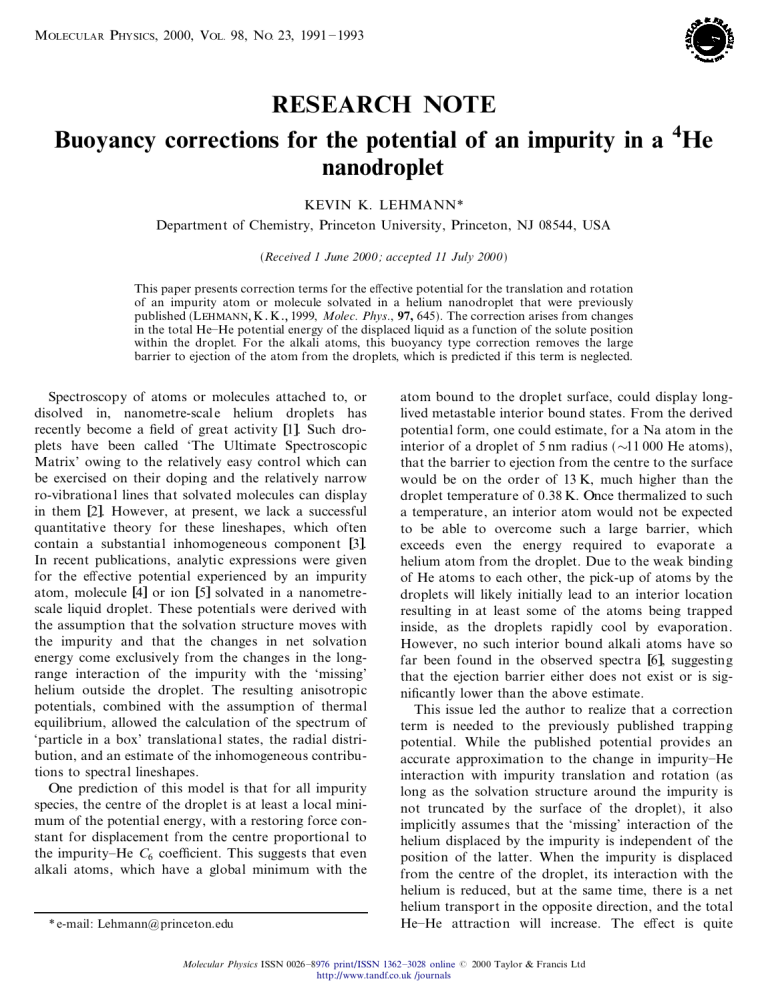
MOLECULAR PHYSICS, 2000, VOL. 98, NO. 23, 1991 ± 1993 RESEARCH NOTE Buoyancy corrections for the potential of an impurity in a 4He nanodroplet KEVIN K. LEHMANN* Department of Chemistry, Princeton University, Princeton, NJ 08544, USA (Received 1 June 2000; accepted 11 July 2000) This paper presents correction terms for the e ective potential for the translation and rotation of an impurity atom or molecule solvated in a helium nanodroplet that were previously published ( L EHMANN, K . K ., 1999, Molec. Phys., 97, 645). The correction arises from changes in the total He± He potential energy of the displaced liquid as a function of the solute position within the droplet. For the alkali atoms, this buoyancy type correction removes the large barrier to ejection of the atom from the droplets, which is predicted if this term is neglected. Spectroscopy of atoms or molecules attached to, or disolved in, nanometre-scal e helium droplets has recently become a ® eld of great activity [1]. Such droplets have been called `The Ultimate Spectroscopic Matrix’ owing to the relatively easy control which can be exercised on their doping and the relatively narrow ro-vibrational lines that solvated molecules can display in them [2]. However, at present, we lack a successful quantitative theory for these lineshapes, which often contain a substantial inhomogeneous component [3]. In recent publications, analytic expressions were given for the e ective potential experienced by an impurity atom, molecule [4] or ion [5] solvated in a nanometrescale liquid droplet. These potentials were derived with the assumption that the solvation structure moves with the impurity and that the changes in net solvation energy come exclusively from the changes in the longrange interaction of the impurity with the `missing’ helium outside the droplet. The resulting anisotropic potentials, combined with the assumption of thermal equilibrium, allowed the calculation of the spectrum of `particle in a box’ translational states, the radial distribution, and an estimate of the inhomogeneous contributions to spectral lineshapes. One prediction of this model is that for all impurity species, the centre of the droplet is at least a local minimum of the potential energy, with a restoring force constant for displacement from the centre proportional to the impurity± He C6 coe cient. This suggests that even alkali atoms, which have a global minimum with the * e-mail: Lehmann@princeton.edu atom bound to the droplet surface, could display longlived metastable interior bound states. From the derived potential form, one could estimate, for a Na atom in the interior of a droplet of 5 nm radius ( ¹11 000 He atoms), that the barrier to ejection from the centre to the surface would be on the order of 13 K, much higher than the droplet temperature of 0:38 K. Once thermalized to such a temperature, an interior atom would not be expected to be able to overcome such a large barrier, which exceeds even the energy required to evaporate a helium atom from the droplet. Due to the weak binding of He atoms to each other, the pick-up of atoms by the droplets will likely initially lead to an interior location resulting in at least some of the atoms being trapped inside, as the droplets rapidly cool by evaporation. However, no such interior bound alkali atoms have so far been found in the observed spectra [6], suggesting that the ejection barrier either does not exist or is signi® cantly lower than the above estimate. This issue led the author to realize that a correction term is needed to the previously published trapping potential. While the published potential provides an accurate approximation to the change in impurity± He interaction with impurity translation and rotation (as long as the solvation structure around the impurity is not truncated by the surface of the droplet), it also implicitly assumes that the `missing’ interaction of the helium displaced by the impurity is independent of the position of the latter. When the impurity is displaced from the centre of the droplet, its interaction with the helium is reduced, but at the same time, there is a net helium transport in the opposite direction, and the total He± He attraction will increase. The e ect is quite Molecular Physics ISSN 0026 ± 8976 print/ ISSN 1362± 3028 online # 2000 Taylor & Francis Ltd http:// www.tandf.co.uk /journals 1992 Research Note Table 1. Buoyancy corrections for the interaction of an alkali atom with a helium nanodroplet. The He± M ¼ values are taken from the ab inito calculations of Pascale [9]. C6 coe cients given in atomic units (i.e. Eh a60 ). The He± M C6 coe cients are taken from KleinekathoÈ fer et al. [10] and the He± He C6 coe cient taken from Spelsberg et al. [7]. ¯ Li Na K Rb Cs ¼=A D n ¡D n C6 (He± He) 5.36 5.5 6.44 6.69 7.14 14.1 15.1 24.4 27.2 33.2 720.2 721.8 734.9 739.0 747.5 C6 (He± M) C6 (e ective) 22.507 23.768 34.038 36.289 41.417 2.3 2.0 70.9 72.7 76.1 analogous to the well known buoyancy correction to the gravitational potential of an object in a ¯ uid, and thus we will give the same name to the corrections for this term in the present case. In the approximation of a cavity much smaller than the size of the droplet, the leading correction is found by replacing the C6 for the impurity ± He long range interaction by C6 ¡ D nC6He , where D n is the net number of helium atoms displaced by the impurity and C6He ˆ 1:430 Eh a60 is the He± He C6 [] ˆ coe „ cient 7 . For an atomic impurity, D n 4º … »e ¡ »… r††r2 dr, where »e is the equilibrium helium ¯ number density (0.0218 A ¡3 ) and »… r† is the radial distribution of He density around the impurity. In the `bubble model’ [8], D n ˆ … 4=3†º¼3 »e , where ¼ is the radius of the bubble which will be expected to be nearly the zero-potential radius of the impurity± He potential. Table 1 contains the C6 , the bubble model prediction for D n, and the buoyancy-correcte d e ective C6 for motion of alkali atoms in helium nanodroplets. It is seen that the buoyancy correction almost matches the bare alkali± He interaction. Regardless of whether the net C6 is positive (implying the centre is a potential minimum) or negative (implying a maximum), it is evident that the energetic cost of interior displacement of an alkali impurity is at least one order of magnitude less than that estimated neglecting the buoyancy correction. As such, we can now predict that, even if there is a barrier to ejection of the alkali atom from the droplet interior, this barrier is at most ¹1 K, and thus that it can be easily overcome by thermal energy even at the droplet’ s temperature. Thus, the experimental lack of metastable interior atoms is now easily rationalized. For atoms and molecules more strongly solvated by the helium, the buoyancy corrections are expected to be smaller. This is because the strongly enhanced solvation density near the impurity will at least partially compensate for the helium displaced from the repulsive regions of the potential. For example, using the isotropic helium density around SF6 reported by Barnett and Whaley [11], a D n ˆ 0… §1† is calculated, leading to a buoyancy correction to the e ective potential for impurity motion of less than 4%. For molecular impurities, the anisotropy of the displaced helium will contribute to the anisotropy of the net potential, which couples impurity translational and rotational motions [4]. Consider an axially symmetric impurity at a distance a from the centre of a droplet of radius R, making an angle À between the symmetry axis of the molecule and the displacement vector from the centre of the droplet. We describe the axially symmetric helium density as »… r;³† around the impurity. Doing a second-order Taylor expansion of the interaction with respect to displacement and then averaging over the di erence »e ¡ »… r;³† gives the following expression for the buoyancy contributions to the potential: … R6 D UBuoyancy ˆ ¡ ‰ »e ¡ »… r; ³†Š dV V He … R 2 ¡ a2 † 3 2 " # 3R6 4 a2 ¡ 1‡ 3 R 2 ¡ a2 … R 2 ¡ a2 † 4 … £ ‰ »e ¡ »… r; ³†Šr2 dV ¡ £ ¡ … 6R6 a … R2 ¡ a2 †4 ‰ »e ¡ »… r; ³†Šr cos … ³† dV 16R6 a2 … R 2 ¡ a2 † 5 … £ P2… cos … À†† ; cos … À† ‰ »e ¡ »… r; ³†Šr2 P2… cos … ³†† dV … 1† He 3 where V He sets the natural energy 2 ˆ …4º» e C6 =3R scale for the buoyancy correction. These expressions allow the leading buoyancy correction terms to be calculated from the anisotropic He solvation density. Using the He density around HCN recently calculated by Draeger and Ceperley [12] using the Path Integral Monte Carlo method, the above integrals have been ¯ ¡3 evaluated. In this calculation, »e ˆ 0:019 27 A was used since this is the helium density found `outside’ the solvation structure but before the density drop as the surface of the droplet is approached. The ® rst integral gives a net displacement of ¡17 He atoms (i.e. an enhancement). This leads to a predicted buoyancy correction to the force constant ¹1.6 times as large as that predicted based upon the HCN ± He interactions alone. This will lead to a predicted increased con® nement of the HCN near the centre of the nanodroplet. Previously, the dominant anisotropic term was the P2… cos … À†† term. Using the calculated value of 1993 Research Note „ 2 ‰ »e ¡ »… r; ³†Šr2 P2… cos … ³†† dV ˆ 32 A , the leading anisotropic term for small displacements from the centre is found to have a buoyancy correction of ¹¡0.12 times the direct HCN± He term. The e ect of these changes are not expected to change the qualitative predictions of the previous paper, although quantitatively, the importance of the potential anisotropy will be reduced and the hydrodynami c coupling increased. The author plans to revisit the prediction of inhomogeneou s lineshapes once he has obtained estimates of the C± H vibrational dependence of the C6 coe cients, since the existing experimental data indicates a strong vibrational dependence of the lineshapes of the R(0) transitions. ¯ This work was supported by the Air Force O ce of Scienti® c Research and by the National Science Foundation. The author wishes to thank Erik Draeger and Professor David Ceperley for making their He densities available to the author in advance of publication, and Carlo Callegari who computed the weighted integrals over this density used in this work. References [1] T OENNIES, J . P ., and VILESOV, A . F ., 1998, Ann. Rev. phys. Chem., 49, 1. [2] L EHMANN, K . K ., and SCOLES, G ., 1998, Science, 279, 2065. [3] R EINHARD, I ., C ALLEGARI, C ., C ONJUSTEAU, A ., L EHMANN, K . K ., and SCOLES, G ., 1999, Phys. Rev. L ett., 82, 5036. [4] L EHMANN, K . K ., 1999, Molec. Phys., 97, 645. [5] L EHMANN, K . K ., and N ORTHBY, J . A ., 1999, Molec. Phys., 97, 639. [6] C ALLEGARI, C ., H IGGINS J ., STIENEMEIER, F ., and SCOLES, G ., 1998, J. phys. Chem. A, 102, 95. [7] SPELSBERG , D ., L ORENZ , T ., and M EYER, W ., 1993, J..phys. Chem., 99, 7845. [8] L ERNER, P . B., C HADWICK , M . B., and SOKOLOV, I . M ., 1993, J. low temp. Phys., 90, 319. [9] P ASCALE, J ., 1983, T echnical report, Service de Physique des Atoms et des Surfaces (Gif sur Yvette-Cedex, France: CEM/Saclay). [10] K LEINEKATHO M ., ï FER, U ., L EWERENZ and M LADENOVIC, M ., 1999, Phys. Rev. L ett., 83, 4717. [11] BARNETT, R . N ., and W HALEY, K . B., 1993, J. phys. Chem., 99, 9730. [12] D RAEGER , E ., and C EPERLEY, D ., 2000, private communication.

